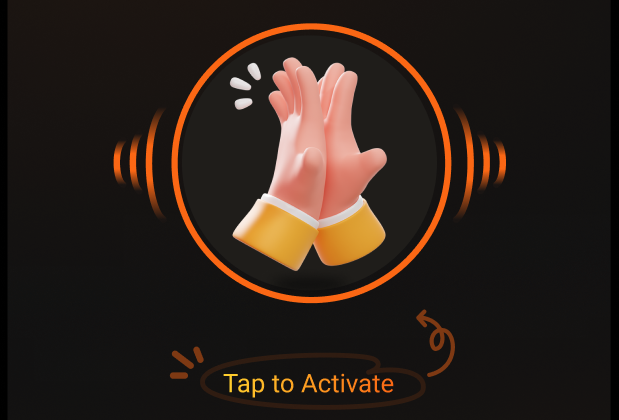
The Evolution of Clap-to-Find Apps
Nowadays, clap-to-find technology has emerged as a practical solution to find misplaced smartphones. It allows users to locate their mobile devices simply by making sounds like clapping or whistling. As technology such as sound recognition has advanced, more and more helpful clap-to-find apps have appeared while enhancing convenience for users like the elderly and visually impaired.
Stage 1: The Early Day of Clap-to-Find Apps
The concept of clap-to-find technology traces its roots back to the early days of smartphones, when developers sought creative solutions for the all-too-common issue of misplaced devices. The first clap-to-find applications emerged around the same time smartphones began to gain widespread adoption, capitalizing on the growing need for effective ways to locate lost phones. These early apps were relatively simple, relying on basic sound recognition algorithms to detect claps and trigger a response from the phone.
Initially, the functionality of these apps was quite rudimentary. Users would clap their hands, and the app would listen for that specific sound pattern. Once detected, the app would activate a pre-programmed response, such as playing a sound or flashing the phone’s screen. This straightforward approach laid the groundwork for what would become a popular category of mobile software, offering a unique solution to a prevalent problem.

As smartphones gained traction in the consumer market, so did the excitement surrounding clap-to-find apps. Users appreciated the novelty and convenience of being able to locate their devices with a simple sound. Numerous factors fueled this initial wave of popularity:
Increased Smartphone Usage: With smartphones becoming ubiquitous in daily life, users often found themselves misplacing their devices in various settings—at home, in cafes, or during travel.
User-Friendly Design: The design of early clap-to-find apps prioritized simplicity. Anyone could easily activate them with minimal setup, making them accessible to a wide range of users.
Social Sharing: The novelty of using sound to find devices led to social sharing among friends and family. Users often demonstrated these apps at gatherings or shared their experiences online, further driving interest and adoption.
Growing Reliance on Technology: As people became more dependent on their smartphones for communication and information, effective solutions for lost devices became increasingly important. Clap-to-find apps offered a straightforward answer to this challenge.
Despite their initial success, these early clap-to-find applications faced challenges as technology advanced. The rise of built-in solutions from smartphone manufacturers and alternative methods for locating devices began to overshadow standalone apps. However, these early innovations laid the foundation for modern click-to-find technology, which continues to evolve and adapt to user needs today.
Stage 2: Technological Advancements in Sound Recognition
Over the years, sound recognition technology has seen significant advancements. Early clap-to-find apps often struggled with accuracy due to background noise and limited processing power. However, advancements in technology have significantly improved sound recognition capabilities. Advanced algorithms, machine learning, noise reduction techniques, and enhanced hardware capabilities have improved detection and classification. Modern clap-to-find apps use sophisticated machine learning techniques to differentiate between intentional sounds (like claps) and ambient noise. Noise reduction technologies filter out background sounds, allowing apps to function effectively in various environments. Apps can now prioritize sounds based on user behavior and environment thanks to the introduction of contextual awareness.
Stage 3: Decline in Popularity
Despite their initial success, clap-to-find apps faced challenges as smartphone manufacturers began incorporating similar features directly into their devices. Companies like Samsung and Google introduced built-in solutions that overshadowed standalone clap-to-find applications, offering users more robust options without needing additional downloads. Moreover, as users gravitated toward multifunctional devices that could perform various tasks, the appeal of dedicated click-to-find apps began to wane. Many users preferred integrated solutions that provided comprehensive device management capabilities rather than relying on a single-function app.
Stage 4: Resurgence of Clap-to-Find Apps
Recently, there has been a resurgence in the popularity of click-to-find apps as developers have reintroduced modern versions that cater to contemporary user needs. For instance, the 2023 launch of “Find My Phone By Clapping” has gained significant traction due to its compatibility with the latest Android versions and its user-friendly interface. Impressive adoption rates reflect the renewed interest in clap-to-find technology; many modern clap-to-find phone apps have surpassed 10 million downloads with average ratings around 4.2 stars. Users appreciate the simplicity and effectiveness of these tools in locating their devices quickly.
Future Trends in Clap-to-Find Technology
Looking ahead, we can anticipate further innovations in clap-to-find technology as developers explore new possibilities to enhance user experience and functionality. One of the most significant areas of advancement is the integration of artificial intelligence (AI) into clap-to-find apps. This integration could lead to even more accurate sound recognition capabilities, allowing apps to better differentiate between various sounds and filter out background noise more effectively. With AI, clap-to-find apps could utilize deep learning algorithms that analyze sound patterns over time. This would enable the app to learn from user interactions, improving its ability to recognize specific claps or whistles while ignoring irrelevant sounds. For example, if a user frequently uses a particular clap pattern, the app could prioritize that sound for activation.
Moreover, the potential applications for click-to-find technology may extend beyond smartphones; we could see similar features integrated into tablets, laptops, or even wearable devices in the future.
Final Thoughts
For those interested in exploring clap-to-find technology further or downloading popular apps, consider checking out your device’s app store for options like Getmobi’s Clap to Find My Phone app or similar alternatives that fit your needs.